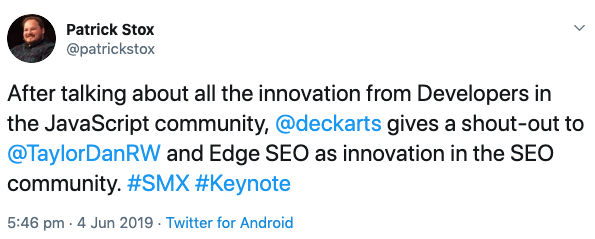What is Edge SEO?
Edge SEO is a field of technical SEO, that utilizes serverless (edge) technologies to execute changes to code through using the CDN as a form of middle-ground in which SEO hotfixes and recommendations can be implemented. These changes are agnostic of the website infrastructure (origin source code), and are supported by multiple CDNs through “edge worker” technology, e.g. Cloudflare Workers, Akamai EdgeWorkers, and Fastly Edge Solution.
Edge SEO offers an implementation solution when:
- Congested development queues/long lead times are impacting SEO implementation and revenue
- Gatekeeper devs who are, unhelpful
- Old platforms/servers that are not scalable
- Website builds that have not originally been scoped properly
- Code freezes
- Legacy duct-tape fixes preventing changes
- Platforms lacking functionality (i.e. Demandware/Salesforce Commerce Cloud not allowing access to server logs)
There’s nothing new about Edge SEO that we’re not already doing, instead, we’ve changed how we do it. By performing SEO implementations on the edge, we are not modifying the underlying code base or current technology stack (servers, CMS, ZXTMs, etc), but instead on a cloud infrastructure.
Why talk to me about Edge SEO?
At TechSEO Boost 2018, I was one of the first SEOs to talk about using edge technologies for SEO purposes in the public realm, and my team’s research into using Cloudflare Workers for performing SEO on the edge won the inaugural 2018 TechSEO Boost Call for Research competition, with Eric Enge and OVH also being named as research and innovation finalists.

I’ve also been credited for coining the term Edge SEO following my talks at TechSEO Boost, articles, and building the Sloth edge SEO tool. I’ve also been described as being a pioneer in the approach of Edge SEO, by software provider DeepCrawl and ContentKing.
You can also read my post talking about using Cloudflare Workers for SEO, on Cloudflare’s blog.
Edge SEO Use Cases
Through custom edge scripts, you have the ability to modify the HTML response of your website to:
- Add, edit and delete meta tags
- Add, edit and delete headers, including adding additional security headers
- Implement HREFLANG based on your rules
- Edit your robots.txt file (not currently possible on Shopify via Cloudflare Workers)
- Serve custom 404 (and 4xx & 5xx) error pages
- Implement and server redirects
- Trim HTML whitespace and comments
- Pre-render JavaScript dynamically using cached versions of pages
- Split test HTML elements (inclusion/removal)
- Full page AB & Multivariate testing
- Pseudo log file analysis (collecting full referrer logs from the request)
Edge SEO Tools

I also helped develop the Sloth Edge SEO Tool, an open-source piece of software that enables SEOs of all Dev ability to produce Cloudflare Worker code bundles (and one-click deploy), making the technology open and accessible to all.
I’ve also been running Cloudflare Workers on my personal site for months now, running my Hreflang setup.
Due to the popularity and increased accessibility of Edge SEO, other tools have since been created with the same functions as Sloth, such as Spark and Huckabuy, using the same model and utilizing Cloudflare’s network as a backbone.
You can also read my Search Engine Journal article on Edge SEO, which has been read more than 12,000 times here.
Edge SEO Examples
AB Testing With Cloudflare Workers
If you go to the URL: https://dantaylor.online/sloth-ab you’ll either end up on a control page or a variant page. This is being handled through Cloudflare Workers as a simple 50/50 split A/B test – which can be easily reported on through Google Analytics, or by using an API puller to produce semi-real time reports in Google Sheets.
Although this practice isn’t “new”, it’s a fairly recent addition to most SEO’s technical arsenal and can be vital in justifying business cases.
Random Number Generation With Akamai EdgeWorkers
function onClientRequest(request) {
⃟◈⃟
Edge SEO Consultancy
Being one of the leaders in making “edge SEO” accessible to all webmasters and marketers, I’m best placed to speak to about taking your SEO serverless. My team and I can help support you and develop custom solutions for edge SEO-as-a-service on a number of CDNs, including:
- AWS Cloudfront (Lambda@Edge)
- Cloudflare (Cloudflare Workers Bundled & Workers Unbound)
- Fastly (no official name, so I call them Fastly Edge Bots)
- Akamai (redirects through Edge Redirector Cloudlet, or Akamai EdgeWorkers)
- Apigee (while not a CDN, can still implement things on the Edge via the AssignMessage Policy)
- Imperva
- Stack Path
⃟◈⃟
Edge SEO Frequently Asked Questions
I get asked a lot of questions around edge SEO and it’s use cases, and as the one credited with coining the term – I’ve included some of the more frequently asked questions (and their responses) below.
What is Edge SEO?
Edge SEO is the name given to the practice of using serverless technologies to execute code changes as a request/response passes through a CDN (middleware), and acts as a middle ground to implementing SEO changes directly on the server/infrastructure, or affecting after the page and DOM has loaded.
This is a solution to resolving issues when other obstacles exist, and should not be performed outside of existing procedures.
Is this the same as CDN SEO?
Technically, no. CDN SEO is making sure that your CDN implementation is configured correctly, e.g. not tar-pitting or rejecting the real Googlebot because it thinks it’s a spoofed user-agent.
What is a CDN?
A CDN (content delivery network) is a geographically distributed network of servers that work together to deliver content in a more efficient manner to users by utilising the closest node in the CDN network in relation to the user’s location. An example of this is Cloudflare’s network of 200+ centers.
Does every CDN offer edge SEO capabilities?
Not all CDNs do, and Cloudflare was one of the first to make it mainstream (although Lambda@Edge has existed for a while). Known CDNs to offer edge capabilities are:
- AWS Cloudfront (Lambda@Edge)
- Cloudflare (Cloudflare Workers Bundled & Workers Unbound)
- Fastly (no official name, so I call them Fastly Edge Bots)
- Akamai (redirects through Edge Redirector Cloudlet, or Akamai EdgeWorkers)
- Apigee (while not a CDN, can still implement things on the Edge via the AssignMessage Policy)
◈◈◈